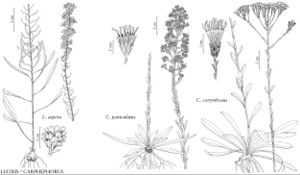Carphephorus
Bull. Sci. Soc. Philom. Paris 1816: 198. 1816.
| Taxon | Illustrator ⠉ | |
|---|---|---|
 | Liatris aspera Carphephorus paniculatus Carphephorus corymbosus | Linny Heagy Linny Heagy Linny Heagy |
Perennials, 20–60+ cm (caudices relatively thick, fibrous-rooted). Stems erect, not branched (± scapiform). Leaves basal and cauline; alternate; ± petiolate (basal) or sessile; blades (usually appressed to strictly ascending) usually 1-nerved, linear to oblanceolate or spatulate, margins entire or remotely dentate (involute in C. pseudoliatris), faces glabrous or hairy, often glanddotted. Heads discoid, in corymbiform to paniculiform arrays. Involucres campanulate to hemispheric, 3–12 mm diam. Phyllaries persistent, (5–) 8–40 in (1–) 2–5+ series, not notably nerved, ovate to elliptic or lanceolate, unequal (herbaceous to scarious). Receptacles convex, paleate or epaleate. Florets 12–35; corollas usually lavender to dark magenta or pinkish purple, sometimes blue, throats funnelform (sometimes externally glanddotted, lengths 4–6 times diams.); styles: bases not enlarged, glabrous, branches linear-clavate (± papillose distally). Cypselae prismatic, ca. 10-ribbed, scabrellous to hispid-strigose, sometimes glanddotted; pappi persistent, of 35–40, barbellulate to barbellate (subequal) bristles in 1–2 series. x = 10.
Distribution
se United States
Discussion
Species 7 (7 in the flora).
Trilisa and Litrisa have been maintained as separate genera (R. M. King and H. Robinson 1987), distinguished primarily by their smaller heads with fewer phyllaries and their lack of receptacular paleae. In other features, their close similarity and relationship to Carphephorus seem evident, and other recent students of the group at species level (e.g., H. J.-C. Hebert 1968; M. D. Correa and R. L. Wilbur 1969; A. Cronquist 1980) have treated the species within a single genus. Forthcoming molecular studies suggest that one or both segregates may be justifiably recognized.
Selected References
Lower Taxa
Key
| 1 | Involucres mostly 3.5–6 mm; phyllaries 5–12 in 1–2(–3) series; receptacles epaleate or partially paleate (paleae 1–2) | > 2 |
| 1 | Involucres mostly (6–)7–12(–15) mm; phyllaries 15–40+ in 3–5+ series; receptacles paleate (peripherally or throughout, paleae 4–33) | > 4 |
| 2 | Stems puberulous to villoso-hirsute and minutely gland-dotted; leaves gland-dotted (basal in rosettes, cauline little developed); phyllaries oblong to oblong-oblanceolate or elliptic-ovate, apices acute to obtuse-mucronate (inner pectinate-ciliate); pappusbristles in ± 2 series | Carphephorus carnosus |
| 2 | Stems glabrous or villoso-hirsute, eglandular; leaves not gland-dotted (basal not in rosettes, cauline ± well developed); phyllaries spatulate to obovate, apices acute to obtuse or rounded (inner not ciliate); pappus bristles in ± 1 series | > 3 |
| 3 | Stems glabrous; heads in flat-topped, corymbiform arrays; peduncles glabrous | Carphephorus odoratissimus |
| 3 | Stems villoso-hirsute; heads in thyrsiform (often ± columnar) arrays; pedunclesstipitate-glandular (each with a subtending bract) | Carphephorus paniculatus |
| 4 | Basal leaves narrowly linear; phyllaries triangular-lanceolate | Carphephorus pseudoliatris |
| 4 | Basal leaves mostly oblanceolate to spatulate; phyllaries ovate-lanceolate to broadly ovate, elliptic, or elliptic-obovate | > 5 |
| 5 | Stems, peduncles, phyllaries, and corollas gland-dotted; phyllaries ovate-lanceolate to broadly ovate, villous and gland-dotted, apices acute to obtuse | Carphephorus tomentosus |
| 5 | Stems, peduncles, phyllaries, and corollas eglandular; phyllaries broadly elliptic to elliptic-obovate, glabrous but for ciliate margins, eglandular, apices rounded | > 6 |
| 6 | Stems glabrous or glabrate (except peduncles); heads in open, loose, usually corymbiform, sometimes paniculiform, arrays; phyllaries broadly elliptic to elliptic-obovate (margins not hyaline, ciliate); cypselae minutely gland-dotted | Carphephorus bellidifolius |
| 6 | Stems villoso-hirsute to short-hirsute; heads in tight, flat-topped, corymbiform arrays; phyllaries broadly elliptic (margins broad, hyaline-scarious, erose or ciliate); cypselae eglandular | Carphephorus corymbosus |
"fine" is not a number.